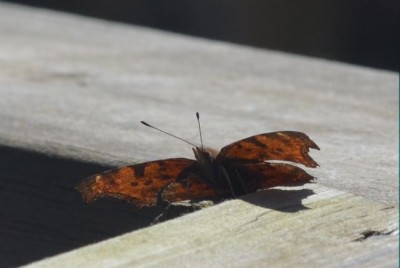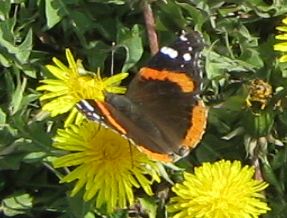In April after the warmest winter on record we went for a ramble through the Rattray Marsh in Mississauga from the Old Poplar parking lot to the shores of Lake Ontario. There are many board walks along the route to keep people from trampling the greenery to death and also to rise above Sheridan Creek and other boggy bits. On one bit of boardwalk, we caught sight of a fairly large, bright orange spotted butterfly.

You can see by this one quick photo that the wings are not rounded at the “corners.” Instead, they are sort of hooked like a jigsaw puzzle piece. The colouring and the odd wing shapes and the extremely early time of year ruled out large numbers of orange butterflies.
Was It a Butterfly or Moth?
Many of you likely remember that most butterflies sit with their wings closed over their back so you can’t get a good photo of them. (Apparently there are other reasons, too, but I’m pretty sure the Blue Morphos at the Butterfly Conservatory do it simply to taunt photographers.) And this insect has its wings wide open. Isn’t it a moth, then?
Nope.
If you look at the antennae, they end in a knob. Actually to me it always looks like a brown cattail shape. Moths almost always have “fuzzy” looking antennae.
This is a butterfly intent on soaking up some spring rays. It was a very crisp day, just slightly above freezing. Some solar power would be very helpful for an ectothermic animal.
What Kinds of Butterfly Wasn’t It?

Red Admirals have a somewhat orange look about them. Their orange, though is limited to stripes or bands across the front wings and along the back edge of the hind wings. Red admirals migrate up to Ontario as soon as it’s warm enough to find food from flowering trees and dandelions.
Painted Lady butterflies have quite a bit of blotchy orange, but they aren’t notched or jigsawed.
 Monarchs, of course, don’t have funny notched wings. A monarch would be noticeably larger than the butterfly we saw. And of course like most people we can recognize a monarch when we see one! Monarchs are later migrating back than Red Admirals.
Monarchs, of course, don’t have funny notched wings. A monarch would be noticeably larger than the butterfly we saw. And of course like most people we can recognize a monarch when we see one! Monarchs are later migrating back than Red Admirals.
Commas versus Question Marks
Now comes the fun bit. I knew it was a “punctuation” butterfly, but I couldn’t remember how to tell if it was a Question Mark or a Comma. Both these butterflies are named after the shape of a mark on the under side of their hind wing.
Now you can see I really have a problem. My photo doesn’t show the underside of the hind wing. I didn’t really see the butterfly closely enough to look for field marks either.
I did a bit of searching around the internet and found another Ontarian had had the same problem. (Check out their blog from the Further Information link below.) Some of their readers had pointed out a difference in the markings on the top of the forewing. It’s worth checking the Kaufman Field Guide to Butterflies of North America to see exactly where and what this mark is.
Basically, it’s like a dash or a French accent mark just after the horizontal row of 3 dots. It’s not near the edge of the wing. It’s at the end of the three dots which is closest to the outer tip of the wing, not the body of the butterfly.
I can’t actually see the top of the fore wing in my photos either. (!) But due to the lighting, you can see the upper markings through the wing.
Based on my photo it appears that this was a Comma, not a Question Mark.
Commas commonly hibernate as adults and, according to Kaufman, are known to pop out for a day’s flying on mild days in late winter and early spring.
This Calls for Another Ramble
Of course looking at Kaufman left me reeling to realize that there is more than one kind of Comma in this area. Argh! So I will definitely have to make another ramble this spring and see if I can get a much better, closer look at any butterflies that grace us with their presence. I’m looking forward to it.
Further Information
An interesting discussion of two similar butterflies called: Question Mark or Comma?
Join In
Have you seen Question Marks or Commas on your spring ramble? Please share your experiences with a comment.

It ( the butterfly ) is a question mark.
Thanks!
I think the real “Question” is why I didn’t get a better photo. I’ll have to do better the next time.